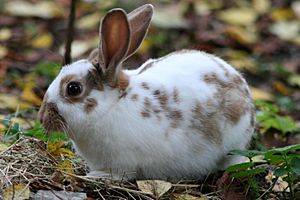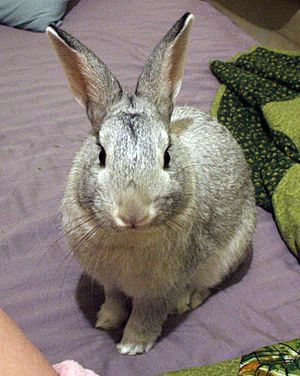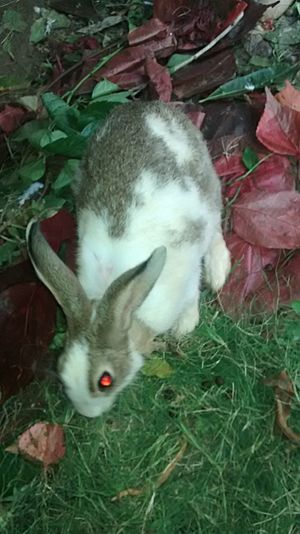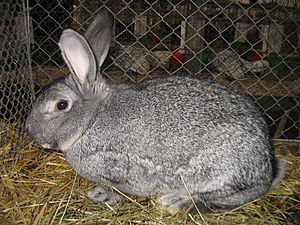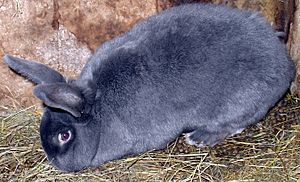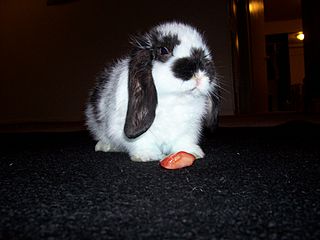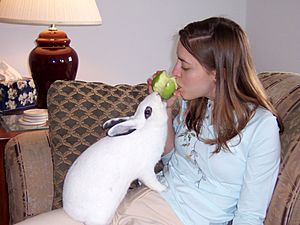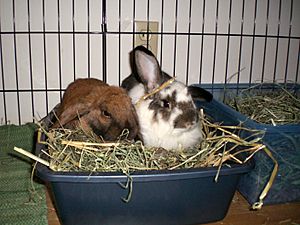Domestic rabbit facts for kids
Quick facts for kids Domestic rabbit |
|
|---|---|
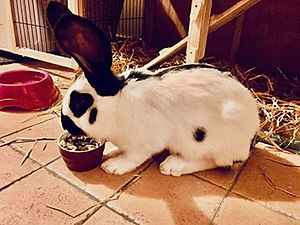 |
|
| A pet rabbit eating in a bowl | |
| Conservation status | |
| Scientific classification | |
| Kingdom: | |
| Phylum: | |
| Class: | |
| Order: | |
| Family: | |
| Genus: | |
| Species: | |
| Subspecies: |
O. c. domesticus
|
| Trinomial name | |
| Oryctolagus cuniculus domesticus (Linnaeus, 1758)
|
|
The domestic rabbit is a type of rabbit that has been tamed by humans. It comes from the European rabbit (Oryctolagus cuniculus).
People keep domestic rabbits for different reasons. Some are raised as livestock for their meat or fur. Others are kept as pets in homes. Just like dogs or cats, there are many different types, called breeds.
The Netherland Dwarf rabbit is a very popular pet breed. Another favorite is the Mini Lop. The biggest rabbit breed is the Flemish Giant. These large rabbits can weigh up to 19.8 pounds (9 kg)! Most pet rabbits live for 7 to 9 years. But if they are well cared for and have good genes, they can live up to 15 years.
Contents
History of Domestic Rabbits
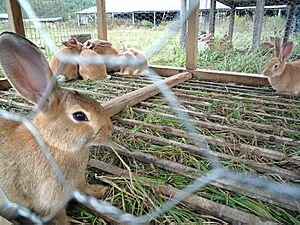
Rabbits were first kept by humans in Rome. They were raised in large, walled areas. This happened a very long time ago.
People started to selectively breed rabbits in the Middle Ages. This means they chose rabbits with certain traits to have babies. They were first tamed as farm animals. By the 1500s, there were already many new breeds. These breeds had different colors and sizes.
In the 1800s, people became more interested in animal fancy. This is a hobby where people breed and show animals. Rabbit fans started to hold rabbit shows and fairs. This happened in Western Europe and the United States. Rabbits were no longer just for food or fur. They were also bred to be beautiful for shows.
Rabbits became popular pets during the Victorian era. This was in the late 1800s. In the United States, the "Belgian Hare Boom" started in 1888. Many Belgian Hares were brought from England. The first rabbit club in America was also started then.
Today, the American Rabbit Breeders Association (ARBA) sets standards for rabbit raising. They also organize rabbit shows. Thousands of rabbit shows happen every year in Canada and the United States. Domestic rabbits are now the third most popular pet in Britain. Only dogs and cats are more popular.
Rabbits are also used in laboratory work. They help scientists make antibodies for vaccines. They also help research human health problems. This includes studies on asthma, stroke prevention, cystic fibrosis, diabetes, and cancer.
Rabbit Names and Terms
Male rabbits are called bucks. Female rabbits are called does. An older word for an adult rabbit is coney. The word rabbit used to mean only young animals.
A young rabbit is often called a bunny. This word is now used for all rabbits, especially pets. Another term for a young rabbit is kit or kitten. A group of rabbits is known as a "colony" or a "nest".
Rabbit Biology
What Rabbits Eat
What a domestic rabbit eats depends on why it is kept. Pet rabbits, meat rabbits, and fur rabbits have different diets. Meat and fur rabbits get food that helps them grow well. This also helps them have healthy babies.
Most countries sell special food pellets for rabbits. Adult rabbits usually get a limited amount of these pellets. This helps prevent them from becoming too heavy. Most pellets are made from alfalfa. They also have other grains for energy. Important minerals and vitamins are added too.
Many rabbit owners also feed their rabbits grass hay. Alfalfa hay is especially good for young rabbits.
How Rabbits Digest Food
Rabbits are special because they digest food in their hindgut. This means they have a large cecum. The cecum helps them break down food they couldn't otherwise use.
When a rabbit eats, food goes to its stomach. Then it moves to the small intestine. Most nutrients are taken out here. After that, food goes to the colon and then the cecum. Muscles in the colon help separate tough and soft food parts. The soft parts go back into the cecum.
Good bacteria in the cecum help digest these soft parts even more. After a few hours, a soft, special poop comes out. It's called a cecotrope. Rabbits eat these soft pellets right away. This is important because the cecotropes are full of vitamin B and other nutrients. This process helps keep their digestion healthy.
Sometimes, these soft pellets might be wet and runny. This is called intermittent soft cecotropes (ISCs). It's different from regular diarrhea. It usually means the rabbit's diet has too much sugar or not enough fiber. Foods like soft fruit or too much lettuce can cause this.
How Rabbits Reproduce
Small rabbit breeds can have babies when they are 4 to 5 months old. Medium breeds are ready at 5 to 6 months. Large breeds are ready at 6 to 7 months. Male rabbits usually take a bit longer to be fully ready.
Rabbits are often spayed (females) or neutered (males). This is done when they are young. It prevents unwanted babies. It also helps with their health and behavior.
Rabbit Genetics and Colors
The study of rabbit genetics helps us understand how traits are passed down. This is important for medical research and for people who raise rabbits. It helps them breed rabbits for specific colors or fur types.
Rabbits have 10 main gene groups that control their color. These are called loci: A, B, C, D, E, En, Du, Si, V, and W. Each group has dominant and recessive genes. Dominant genes show up more easily. Recessive genes only show up if two copies are present.
Rabbit fur only has two main colors: yellow (pheomelanin) and dark brown (eumelanin). A rabbit can also have no color, which makes it albino (white with pink eyes).
Here are some examples of how these genes work:
- "A" genes control patterns like agouti. Agouti means the hair has bands of different colors. (Examples: chestnut agouti, opal, chinchilla)
- "B" genes control black or brown color. (Examples: black, chocolate)
- "C" genes control how much color a rabbit has. Some C genes can make a rabbit fully colored. Others can remove yellow color or make the color lighter. The himalayan gene makes the body white with colored "points" (ears, nose, feet) and pink eyes. The albino gene makes a rabbit all white with ruby-red eyes.
- "D" genes make colors lighter. They can change black to blue, or chocolate to lilac.
- "E" genes affect how black pigment spreads. They can make a rabbit solid black, or remove most black pigment. (Examples: dominant black, steel, harlequin, tortoise)
- "En" genes create spotted patterns. They can make a rabbit mostly white with some color, or have an even mix of color and white.
- "Du" genes create the Dutch pattern. This pattern has white on the face, front body, and back paws. The rest of the fur is colored.
- "V" genes are linked to blue eyes. A rabbit with the vienna white gene can be all white with blue eyes.
- "Si" genes create a silver look, where some hairs are white.
- "W" genes affect the width of yellow bands on agouti fur.
Rabbit Breeds
There are many different types of domestic rabbits. They come in various sizes, personalities, and need different care. Many breeds were made to be much larger than wild rabbits. But selective breeding has also created "dwarf" and "giant" sizes. People keep them for food, fur, and as pets.
The Angora rabbit is known for its long, soft fur. This fur is often spun into yarn, like wool. Other breeds, like the Rex rabbit, are raised for their smooth, velvet-like fur. The American Rabbit Breeders Association recognizes 49 rabbit breeds in the United States. The British Rabbit Council recognizes over 50. There are even more breeds around the world.
Just like dog breeds, rabbit breeds were created for specific traits. They have many different colors. They also vary in fur length, body shape, and ear length. Some rabbits have floppy ears, called lop-eared. Their personalities can also differ. Some are calm, while others are more playful or timid.
Some rabbit breeds can have genetic problems. For example, Holland Lops can have dental issues. Rabbit breeders carefully track these genes. They try to breed out unwanted problems.
Rabbits as Pets
Rabbits have been popular pets in Western countries since the 1800s. Rabbits can form bonds with their owners. They can even learn simple voice commands and come when called. They are curious and enjoy playing.
Rabbits are not the best pets for very young children. They are fragile and can get hurt easily if handled roughly. Loud noises and sudden movements can also scare them.
In the Australian state of Queensland, keeping pet rabbits is not allowed. Rabbits are very popular pets in the United States around Easter. This is because of their link to the holiday. However, animal shelters often get many unwanted rabbits after Easter. These rabbits were bought as gifts, especially for children.
Many humane societies, animal shelters, and rescue groups have rabbits ready for pet adoption. You can also buy fancy rabbit breeds from pet stores or breeders.
House Rabbits
More and more people are keeping rabbits as house pets. They live in "rabbit-proofed" areas. This means dangerous or valuable things are put away so the rabbit can't chew them. Living indoors keeps rabbits safe from dangers outside. These dangers include predators, bad weather, cars, and pesticides. This helps them live longer.
Rabbits usually get along with other small animals. This includes other rabbits, birds, and rodents like chinchillas and guinea pigs.
Keeping rabbits indoors became more popular after books like House Rabbit Handbook were published in the 1980s. This book taught people how to litter-box train rabbits. It also showed how to live with them indoors. The US-based House Rabbit Society was started in 1988.
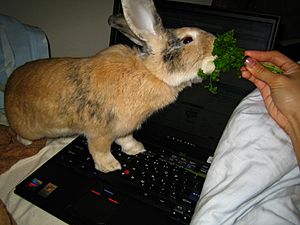
Rabbit Behavior
Rabbits are naturally alert and timid. This is because they are prey animals in the wild. Many of their actions come from their fight-or-flight response to things they see as threats. It can take time and patience to earn a pet rabbit's trust.
Commercial Rabbit Raising
Rabbits for Meat
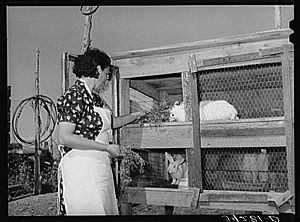
Breeds like the New Zealand and Californian are often raised for meat. These rabbits grow quickly and efficiently. They are usually ready for slaughter when they are about 14 to 16 weeks old.
Young rabbits for meat are called "fryers." They are 70 to 90 days old and weigh 3 to 5 pounds. "Roasters" are older, from 90 days to 6 months, weighing 5 to 8 pounds. Rabbits older than 6 months are called "stewers."
Rabbits for Wool
Rabbits like the Angora, American Fuzzy Lop, and Jersey Wooly produce wool. The larger Angora breeds are used for commercial wool production. Their long fur is cut, combed, or gently pulled out during molting. This wool is then spun into yarn. Angora wool is very warm, about 2.5 times warmer than sheep's wool.
Rabbits in Laboratories
Rabbits are used in laboratory work for important medical research. They help create antibodies for vaccines. They also help study how chemicals affect the body. Rabbits are used to study diseases like asthma, stroke prevention, cystic fibrosis, diabetes, and cancer.
The New Zealand White is a common breed used for research. Some groups believe that animals should not be used for testing, especially for things like cosmetics.
Rabbit Housing
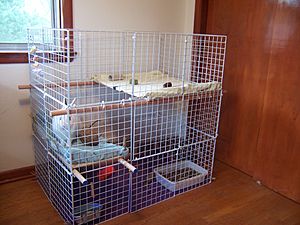
Rabbits can live outdoors in special hutches. These hutches protect them from cold in winter and heat in summer. They also keep rabbits safe from predators. Hutches are often placed in a fenced yard or shed. This area might also have a larger pen for the rabbits to exercise. Sometimes, rabbits can roam freely in a secure area. They might use a modified doghouse for shelter. A more complex setup is an artificial warren, which is like a man-made burrow system.
Images for kids
-
Titian, Madonna of the Rabbit (c. 1530)
See also
 In Spanish: Oryctolagus cuniculus domesticus para niños
In Spanish: Oryctolagus cuniculus domesticus para niños


